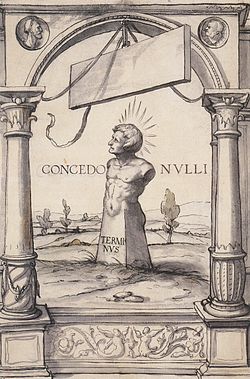Terminus (god)

| Part of a series on |
| Roman mythology |
|---|
| Major gods |
| Topics |
| Other minor Roman deities |
|
t |
In
Ancient writers believed that the worship of Terminus had been introduced to
Worship
The name of the god Terminus was the
These rites were practised by private landowners, but there were also related public ceremonies. Ovid refers to the sacrifice of a sheep on the day of the Terminalia at the sixth
There is some evidence that Terminus' associations could extend from property boundaries to limits more generally. Under the
History
Ancient views
Ancient authors agreed that the worship of Terminus was of
The stone in the Capitoline Temple was believed to have been among the altars located on the Capitoline Hill before the Temple was built under
Modern views
According to the dominant scholarly view during the late 19th and much of the 20th century, Roman religion was originally animistic, directed towards spirits associated with specific objects or activities which were only later perceived as gods with independent personal existence. Terminus, with his lack of mythology and his close association with a physical object, seemed a clear example of a deity who had developed little from such a stage.[4]
This view of Terminus retains some recent adherents,
References
- ISBN 0-19-860641-9.
- ^ a b c d e Ovid, Fasti 2.639–684.
- ^ Siculus Flaccus, De Condicionibus Agrorum 11.
- ^ a b W. Warde Fowler (1899). The Roman Festivals of the Period of the Republic: An Introduction to the Study of the Religion of the Romans. London: Macmillan and Co. pp. 324–327. Retrieved 2007-03-24.
- ^ ISBN 0-500-40041-5.
- ^ Samuel Ball Platner; Thomas Ashby (1929). "Terminus, Fanum". A Topographical Dictionary of Ancient Rome. London: Oxford University Press. p. 512. Retrieved 2007-03-19.
- ^ a b c Dionysius of Halicarnassus, Roman Antiquities 2.74.2–5.
- ^ ISBN 0-8018-5482-2.
- ISBN 0-19-860641-9.
- ^ Varro, De Lingua Latina 6.3; Ovid, Fasti 2.47–54.
- ISBN 0-19-814822-4.
- ^ Varro, De Lingua Latina 5.10.
- ^ .
- ^ Livy 1.55; Dionysius of Halicarnassus, Roman Antiquities 3.69.3–6.
Further reading
- Piccaluga, Giulia (1974). Terminus: I segni di confine nella religione romana (in Italian). Rome: Edizioni dell'Ateneo. OCLC 1989261.
- Woodard, Roger D. (2006). Indo-European Sacred Space. Vedic and Roman Cult. Urbana-Chicago: University of Illinois Press. ISBN 0-252-02988-7.
- Reviewed by Marco V. García-Quintela (2007), Bryn Mawr Classical Review 2007.02.36. Retrieved on June 13, 2007.
External links
![]() The dictionary definition of Terminus at Wiktionary
The dictionary definition of Terminus at Wiktionary
